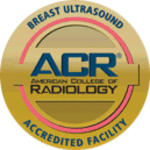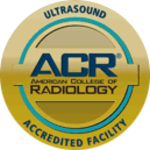Pelvic Ultrasound Quick Reference Guide for Physicians
Ordering Information:
A pelvic ultrasound provides excellent images of the structures and organs in the lower abdomen or pelvis. A Doppler ultrasound exam may also be included on the pelvic ultrasound examination.
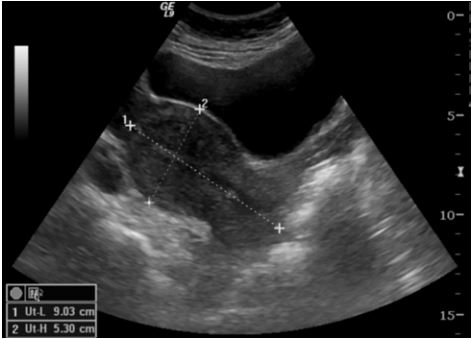
Pelvic Ultrasound performed at Guilford Radiology, 2010
We offer 2 types of pelvic ultrasounds:
transabdominal (76856)
ransvaginal (76830)
In women, a pelvic or abdominal ultrasound is most often performed to evaluate the:
- bladder
- ovaries
- uterus
- cervix
- fallopian tubes
Ultrasound examinations can help diagnose symptoms experienced by women such as:
- pelvic pain
- abnormal bleeding
- other menstrual problems
and help identify:
- palpable masses such as ovarian cysts and uterine fibroids
- ovarian or uterine cancers
A transvaginal ultrasound is usually performed to view the endometrium or the lining of the uterus, including its thickness, and the ovaries. Transvaginal ultrasound also affords a good way to evaluate the muscular walls of the uterus, called the myometrium.
In men, a transabdominal pelvic ultrasound (76856) is used to evaluate the:
- bladder
- seminal vesicles
- prostate
How is the procedure performed?
Transabdominal:
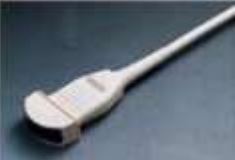
Transabdominal transducer
For most ultrasound exams, the patient is positioned lying face-up on an examination table that can be tilted or moved.
A clear water-based gel is applied to the area of the body being studied to help the transducer make secure contact with the body and eliminate air pockets between the transducer and the skin. The sonographer (ultrasound technologist) then presses the transducer firmly against the skin in various locations, sweeping over the area of interest or angling the sound beam from a farther location to better see an area of concern.
Transvaginal:
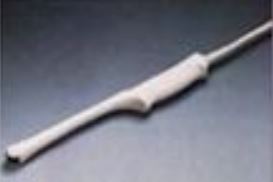
Transvaginal transducer
Transvaginal ultrasound is performed very much like a gynecologic exam and involves the insertion of the transducer into the vagina after the patient empties her bladder. The tip of the transducer is smaller than the standard speculum used when performing a Pap test. A protective cover is placed over the transducer, lubricated with a small amount of gel, and then inserted into the vagina. Only two to three inches of the transducer end are inserted into the vagina. The images are obtained from different orientations to get the best views of the uterus and ovaries.
How should the patient prepare? The patient should wear comfortable, loose-fitting clothing for this ultrasound exam. She may need to remove all clothing and jewelry in the area to be examined. She may be asked to wear a gown during the procedure. For the transabdominal pelvic ultrasound, a full bladder is needed to visualize pelvic organs. Please have your patient drink 32 ounces of fluid 1 hour prior to the exam. No preparation is necessary for a transvaginal pelvic ultrasound.
Ready to Order a Test for your Patient?
General Information
What is Ultrasound?
Ultrasound imaging or sonography, involves exposing part of the body to high-frequency sound waves to produce pictures of the inside of the body. Ultrasound exams do not use x-rays. Because ultrasound images are captured in real-time, they can show the structure and movement of the body's internal organs, as well as blood flowing through blood vessels. Ultrasound imaging is a noninvasive medical test that helps physicians diagnose and treat medical conditions.
Doppler ultrasound is a special ultrasound technique that evaluates blood flow through a blood vessel, including the body's major arteries and veins in the abdomen, arms, legs and neck. Ultrasound scanners consist of a console containing a computer and electronics, a video display screen and a transducer that is used to scan the body and blood vessels. The transducer is a small hand-held device that resembles a microphone, attached to the scanner by a cord. The transducer sends out high frequency sound waves into the body and then listens for the returning echoes from the tissues in the body. The principles are similar to sonar used by boats and submarines.
The ultrasound image is immediately visible on a nearby video display screen that looks much like a computer or television monitor. The image is created based on the amplitude (strength), frequency and time it takes for the sound signal to return from the patient to the transducer and the type of body structure the sound travels through.
How does the procedure work?
Ultrasound imaging is based on the same principles involved in the sonar used by bats, ships and fishermen. When a sound wave strikes an object, it bounces back, or echoes. By measuring these echo waves it is possible to determine how far away the object is and its size, shape, and consistency (whether the object is solid, filled with fluid, or both). In medicine, ultrasound is used to detect changes in appearance of organs, tissues, and vessels or detect abnormal masses, such as tumors.
In an ultrasound examination, a transducer both sends the sound waves and records the echoing waves. When the transducer is pressed against the skin, it directs small pulses of inaudible, high-frequency sound waves into the body. As the sound waves bounce off of internal organs, fluids and tissues, the sensitive microphone in the transducer records tiny changes in the sound's pitch and direction. These signature waves are instantly measured and displayed by a computer, which in turn creates a real-time picture on the monitor. One or more frames of the moving pictures are typically captured as still images. Doppler ultrasound, a special application of ultrasound, measures the direction and speed of blood cells as they move through vessels. The movement of blood cells causes a change in pitch of the reflected sound waves (called the Doppler effect). A computer collects and processes the sounds and creates graphs or color pictures that represent the flow of blood through the blood vessels.
How is the procedure performed?
For most ultrasound exams, the patient is positioned lying face-up on an examination table that can be tilted or moved.
A clear water-based gel is applied to the area of the body being studied to help the transducer make secure contact with the body and eliminate air pockets between the transducer and the skin. The sonographer (ultrasound technologist) then presses the transducer firmly against the skin in various locations, sweeping over the area of interest or angling the sound beam from a farther location to better see an area of concern.
Doppler sonography is performed using the same transducer.
When the examination is complete, the patient may be asked to dress and wait while the ultrasound images are reviewed. This ultrasound examination is usually completed within 30 to 60 minutes.






